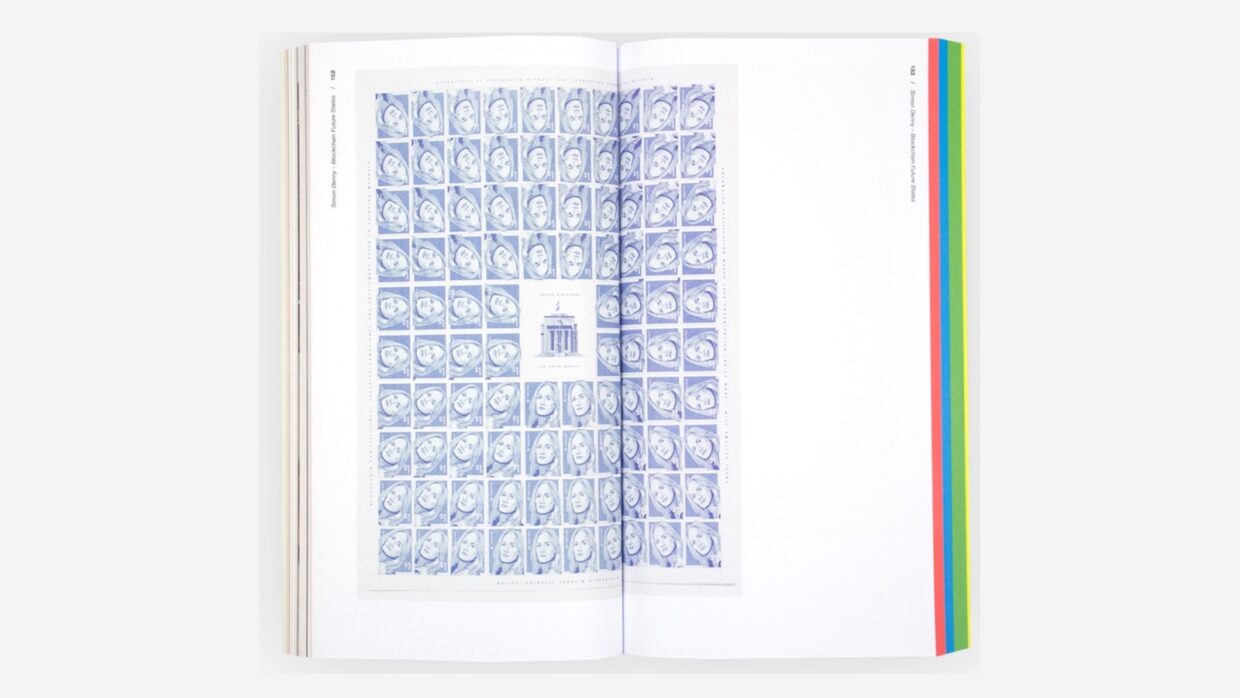Released by Torque Editions back in 2017, Artists Re:Thinking the Blockchain explores the intersecting artistic, speculative, conceptual, and technical engagements with the technology.
Edited by Ruth Catlow, Marc Garrett, Nathan Jones & Sam Skinner, the book features a range of commissioned work. Arranged into three sections — Documents, Fictions, and Theory — the work includes essays, illustrations, and art documentation exploring what the blockchain might mean for our collective futures.
Here’s a selection of three essays summarizing some core ideas of Catlow’s book.
Documents: FinBook: Literary Content as Digital Commodity
One of the most intriguing essays/projects in this book, written by Rory Gianni, Hadi Mehrpouya, Dave Murray-Rust, Bettina Nissen, Shaune Oosthuizen, Chris Speed, and Kate Symons, is a web-based project called Finbook, an interface where readers and bots can trade on the value of chapters included in the book.
At the end of each article is a QR code enabling readers to access a website which displays the “economic performance” of each article as determined by the FinBook authors. Operating both as social commentary on how algorithms are replacing people on trading floors, the FinBook model turns this on its head as it turns the work of each author into an “investment portfolio, mediated by the market and the attention of readers.”
Each article wallet has a single FinBot which runs on an automated trading platform. Based on the content of each author’s article, the FinBots have been designed to reflect the characteristics of each chapter. For the Finbot to start investing, it must have as many tags as possible, which determines where the bot invests in. Each bot has a trading history and an ongoing investment portfolio.
This is a wickedly clever intervention — FinBot goes beyond the “current market places of online booksellers by facilitating the direct trading of the content itself.”
The authors pose a simple question: to whom or in what do we place our trust in a decentralized economy? Using this software to reflect on the uncomfortable aspect of “data commodification by asking readers to trade directly in cultural capital,” in a market populated by both human and non-human actors, FinBot provides “broader insights into the complexities of engendering trust in a decentralized environment.”
Fictions: All That Happened
This speculative function by artist collective Surfatial surveys the potential future blockchain worlds can be glimpsed through, offering a creative example of the blockchain.
In Vonnegutesque style, the story opens with a celebration at a planetarium celebrating the presence of three visitors from another land. These visitors had brought with them the “Large Surface Perspectivescope” and intended to demonstrate its use. The LSP was a device that was, according to the visitors, capable of helping others see a viewpoint that seemed neutral and democratic by introducing an “element of distance.”
Composed of a series of telescopes of different sizes, any member of the planetarium could enter and connect their own telescope to the chain of telescopes. This network of telescopes was modeled to organize the ever-growing of telescopes, so that “none were prioritized over another and the perspective of every telescope was available to every other, if needed.”
This series was working to solve multiple problems with the current system; specifically to allow each object in the night sky to be included in the atlas, not just the celestial bodies. Anyone could add a telescope — so any perspective could be included.
The LSP, as such, is a genuinely open marketplace — a blockchain, that, is an “ideal system” that “worked at least for some time.”
Theory: Collections Management on the Blockchain: A Return to the Principles of the Museum
Helen Kaplinsky describes the blockchain as a “move from a model of security based on embodied trust to smart contracts executed via a trustless network.”
Yet, within the museum, according to the western ideal, “the final resting place for an artwork is the museum.” The blockchain, according to Kaplinsky, appears as a new mitigating relationship, a counter to the Enlightenment paradigm that the museum defines as what is “visible by how space and time [are] organized.”
Kaplinsky speaks about how value systems embedded in blockchain databases could still reinforce an existing “colonial impulse for the public management of cultural assets.” Yet, the blockchain might offer museums reputation management, building upon established Web 2.0 systems. Allowing for an asynchronous display of objects, museums could allow audiences to produce meaning and value through audience interaction by creating a blockchain database.
This, in essence, is what Kaplinsky means by working against the colonial impulse within museums.
Praise:
“The book strikes a great balance between technical explanation of blockchains, cryptocurrency and smart contracts and the broader politics, culture and philosophy that surrounds the innovations. Above all, it inspires us to believe we can still invent our own futures and grow the technologies that we need to realize them.’
– Brett Scott, author of The Heretic’s Guide to Global Finance: Hacking the Future of Money
“This book is on a mission to make one of the most influential yet unknown technologies of today intelligible for each and every one of us.”
– Josephine Bosma, author of Nettitudes – Let’s Talk Net Art
The book is available for free on Torque.



